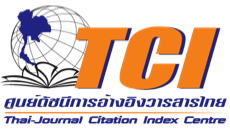แนวทางการจัดการท่องเที่ยวโดยใช้คติชนของชุมชน (Processes for Tourism Management by The Folklore of the Community)
คำสำคัญ:
การท่องเที่ยว/ชุมชน /คติชน /การเรียนรู้ /การถ่ายทอดความรู้บทคัดย่อ
การวิจัยมีวัตถุประสงค์เพื่อศึกษาสภาพของการเรียนรู้ การถ่ายทอดความรู้ และบทบาทของ
คติชนที่เกี่ยวข้องกับการจัดการท่องเที่ยวโดยชุมชน เงื่อนไขของความสำเร็จในการใช้ข้อมูลทางคติชนวิทยาในการจัดการท่องเที่ยวโดยชุมชน และนำเสนอแนวทางการจัดการท่องเที่ยวโดยใช้คติชนของชุมชน กลุ่มตัวอย่าง คือ ชุมชนที่จัดการท่องเที่ยว จำนวน 148 แห่ง และชุมชนที่เป็นชุมชนต้นแบบจำนวน 4 แห่ง ผลการวิจัยพบว่า สภาพของการเรียนรู้ในชุมชนท่องเที่ยวยังมีคติชนอยู่ โดยปราชญ์ท้องถิ่นเป็นผู้เรียนรู้และถ่ายทอดคติชน ด้านบทบาทของคติชน พบว่า คติชนมีบทบาทต่อการจัดการท่องเที่ยวของชุมชน ด้านเงื่อนไขของความสำเร็จ พบว่า การพัฒนาคน การเลือกใช้คติชน และการสร้างเครือข่าย เป็นเงื่อนไขสำคัญที่ทำให้ประสบความสำเร็จ ด้านแนวทางการจัดการท่องเที่ยวโดยใช้คติชนของชุมชน แบ่งออกเป็น 9 ขั้นตอน ได้แก่ ขั้นที่ 1 การสร้างความเข้าใจ ขั้นที่ 2 การสร้างการมีส่วนร่วมของชุมชน ขั้นที่ 3 การติดอาวุธทางปัญญา ขั้นที่ 4 การสืบค้นคติชนเพื่อการท่องเที่ยว ขั้นที่ 5 การวิเคราะห์ตนเอง ขั้นที่ 6 การบริหารจัดการการท่องเที่ยวโดยใช้คติชนของชุมชน ขั้นที่ 7 การจัดทำนวัตกรรมเพื่อการท่องเที่ยว ขั้นที่ 8 การสร้างเครือข่ายสนับสนุนการจัดการท่องเที่ยว และขั้นที่ 9 การประเมินผล
The purposes of this research were to study the learning conditions, sharing knowledge and study the role of folklore related to Community Based Tourism management, to study the conditions of success by using information of folklore in order to manage the Community Based Tourism and to present guidelines of tourism management by using the community folklore. The sample groups were 148 tourism management communities and the 4 best practiced communities. The results of this research revealed that the sitvation in tourism community still has folklore, which has learned and relayed by the local sage. In addition, the folklore played an important role for the Community Based Tourism management. In term of the conditions of success, the results found that, human development, selecting the folklore, and providing supporting network that was an important condition in successful tourism management. Moreover, the guidelines for tourism management using community folklore have classified into nine steps as follow; Step 1: Creating understanding, Step 2: Creating community participation, Step 3: Searching for folklore, Step 4: Operating intellectual weapons, Step 5: Self-analysis, Step 6: Making tourism routes, Step 7: Making innovation for tourism management, Step 8: Making a support network, and Step 9: Evaluation.





